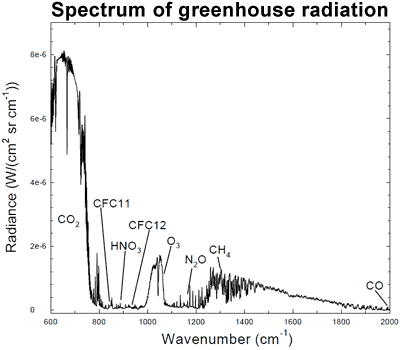Human Fingerprint on Climate Change: More heat returning to earth
Humans emit over 30 billion tonnes of carbon dioxide into the atmosphere every year. As we add more CO2 to the atmosphere, it traps more heat. How do we check this? Real world measurements find that extra CO2 is trapping more heat. We’ve already seen that satellites find less heat escaping out to space (see Human Fingerprint #2). This is direct observational proof that the warming effect from CO2 is increasing.
We have further confirmation that extra CO2 is trapping more heat by surface measurements (see Human Fingerprint #4). With less heat escaping out to space, more heat is returning to the Earth’s surface. At the surface, we’re observing more infrared radiation coming back down to Earth from the atmosphere.
What about the argument that the CO2 effect is saturated? This is based on the mistaken notion that our atmosphere is a single layer of CO2 blocking heat like a Venetian blind. In reality, our atmosphere is made up of many layers and each layer radiates heat.
When we add more CO2 into the air, it mixes throughout the atmosphere including upper layers. The extra CO2 in higher layers of the troposphere absorbs radiation from the lower levels. So adding extra CO2 to the atmosphere is adding to global warming.
That less heat is escaping out to space is confirmed by surface measurements that find more infrared radiation returning to earth. Several studies have found this is due to an increased greenhouse effect (Philipona 2004, Wang 2009). An analysis of high resolution spectral data allows scientists to quantitatively attribute the increase in downward radiation to each of several greenhouse gases (Evans 2006). The results lead the authors to conclude:
"this experimental data should effectively end the argument by skeptics that no experimental evidence exists for the connection between greenhouse gas increases in the atmosphere and global warming."

Figure 5: Spectrum of the greenhouse radiation measured at the surface. Greenhouse effect from water vapor is filtered out, showing the contributions of other greenhouse gases (Evans 2006).
![]() This page is an extended version of A Scientific Guide to the 'Skeptics Handbook'. You can download the Scientific Guide as an A5 PDF or a printable A4 PDF that can be folded into an A5 booklet. Translations of the Scientific Guide are available here.
This page is an extended version of A Scientific Guide to the 'Skeptics Handbook'. You can download the Scientific Guide as an A5 PDF or a printable A4 PDF that can be folded into an A5 booklet. Translations of the Scientific Guide are available here.































 Arguments
Arguments



























